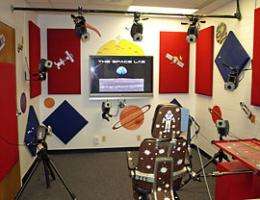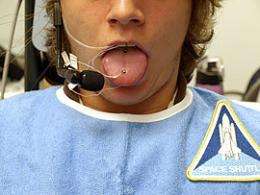Speech Machine May Help Kids With Cerebral Palsy

(PhysOrg.com) -- A new research laboratory at the UT Dallas Callier Center for Communication Disorders is for the first time investigating speech movements in children with cerebral palsy, and the researchers have created an out-of-this-world experience to reflect the lab’s name.
The Speech And Communication Exploration (SPACE) lab will focus on tongue and lip movements of children with cerebral palsy and compare them with those of typical children and adults.
“There has never been a speech movement study completed on children with cerebral palsy,” said Dr. Jennell Vick, principal investigator for the study. “So it is fair to say we are going where no man has gone before.”
The SPACE lab is currently recruiting children ages 10 to 15 years old with and without cerebral palsy. Prior to enrolling in the study, the participants will undergo standardized testing that includes reading words and sentences aloud, a hearing screening and an oral structure examination.
Once selected for the study, the participants will visit the Callier Center’s NASA-inspired SPACE lab where they will sit in the “pilot’s” chair and communicate with “mission control.”

“The technology we are using allows children to communicate freely with their typical body movements and gestures,” said Vick. “Previous technology required participants to sit completely still with a halo device around their head. Since children are much more active when they communicate, this technology didn’t work well on younger research participants.”
The SPACE lab is using the Northern Digital Inc. Wave System to collect the speech movements. It is on loan from the company and one of only four machines in the world.
By simply placing a small sensor on the child’s tongue and lips, researchers are able to detect the direction, distance and smoothness of the movements as words are created. In children with cerebral palsy, speech movements tend to be affected by spasticity, which can make their speech more difficult to understand than typical children.
“The goal is to understand the difference in how the tongue and lips move during speech so that researchers and clinicians can improve speech therapy and treatment,” said Vick. “From the babbling produced by babies to the mature speech produced by adults, we hope to better understand how the movements of the mouth enable people to be understood by others.”
Provided by University of Texas at Dallas (news : web)
















